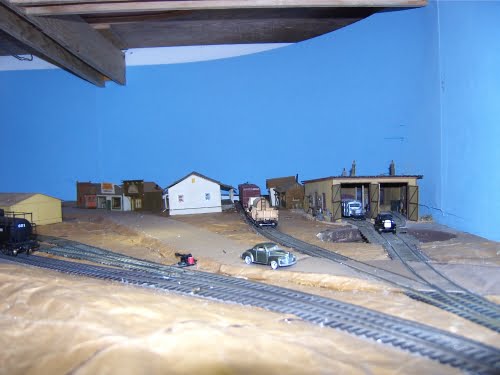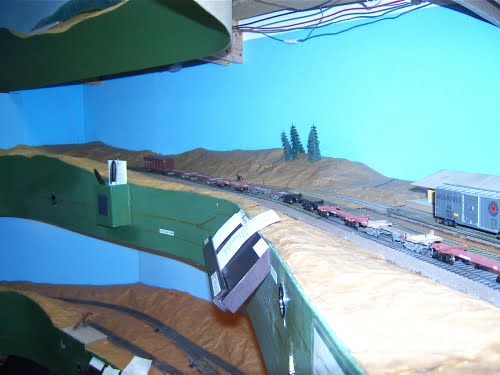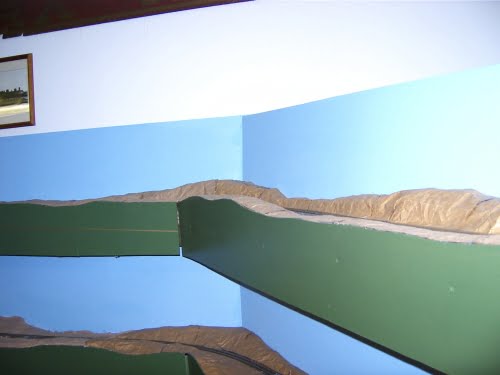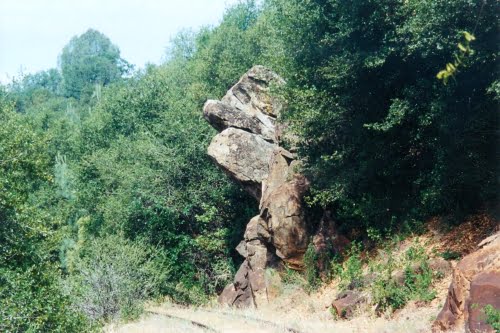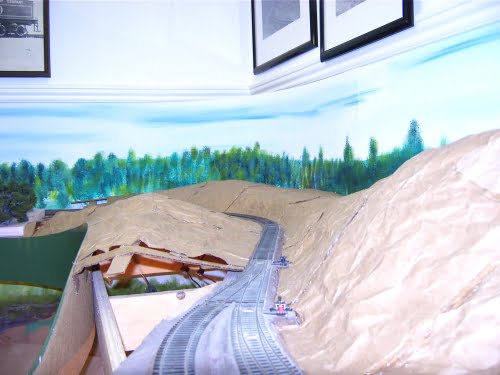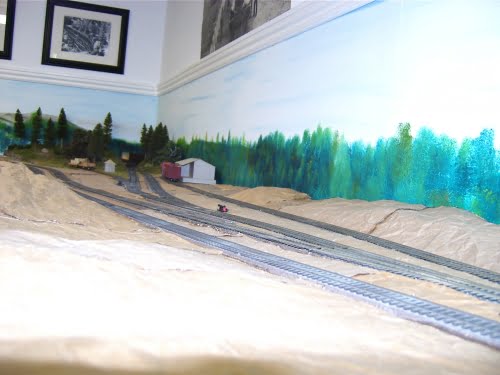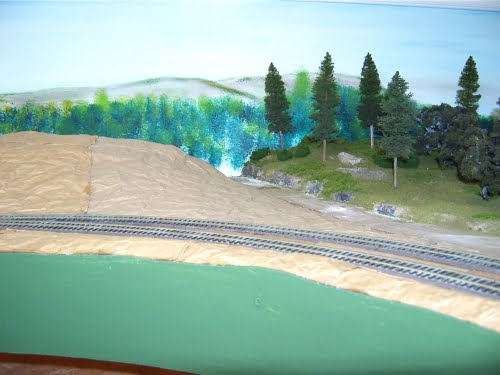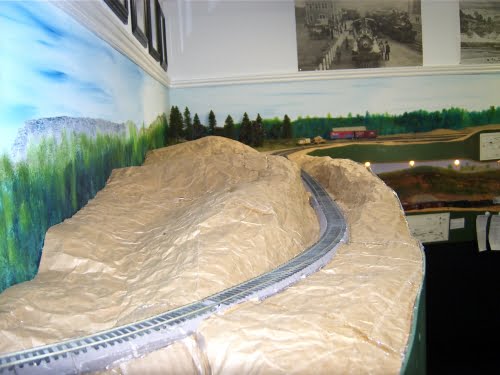Sierra Railroad 1955
Lime Kiln to Tuolumne
The siding at Lime Kiln. (12-09)
Lime Kiln and its three car spotting locations. The car capacity at Lime Kiln is 5 cars which means there is usually a couple of cars on siding to make things interesting. The red and black “barrels” on the Caboose Industry ground throw makes it easier to throw the ground throw, you don’t have dig the ground throw handle out of the scenery. Plus the black “barrel” indicates the normal route and the red “barrel” represents the diverging route making it easier for the operator to see how the turnout is thrown. (12-09)
The mainline heading into Sonora from Lime Kiln. (12-09)
The west end of Sonora. The Blackjack Hopper has been spotted on the unloading spur, see the photo in the prototype section, the tank car is a Standard Oil car, the two box cars behind the tank car have been spotted at the Sonora Freight house. To the left and behind the Freight house is the Hales & Symons spur which has two spots for cars. (12-09)
The Sonora depot (or at least a stand in model). Although it was gone by 1955 I will model the Sonora depot one of these days. The green building behind the station represents the Sash & Door Factory that was part of Standard Lumber Co mill when it was located in Sonora. Here is another case of selective memory since the Mill was moved to Standard in the early 1920’s. (12-09)
One car spotted at Sewall’s Foundry which is located in the “hole” at Sonora. The track down to the Foundry is on a 5% grade so it’s one car in and out at a time. The empty space in front of Sewall’s will be the location of Tuolumne County General Hospital. The building will be kit bashed from two Bar Mills Idaho Hotel kits. (12-09)
Looking east as you leave Sonora. The scenery base of brown paper bags make a big difference in the look of the layout. (12-09)
January 2011 – Fassler with the base scenery added. In the upper left hand corner you can see some of the scenery base and backdrop of WSLCo mainline as it heads to Camp 24.
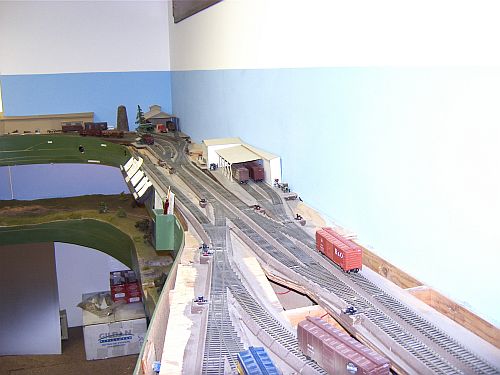
The view of Fassler as you come down the stairs into the Crew Lounge area. The cars at the bottom of the photo have been spotted at Fassler Storage and are waiting to be loaded at one of the loading tracks around the mill. The building in center of the photo is the Box Factory and the building in the back corner is the Planner.
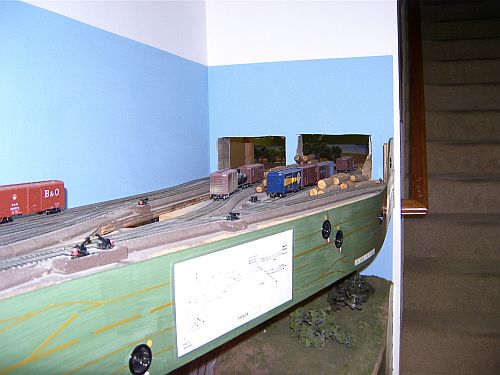
Looking back towards the stairs and where the track enters into Fassler. The mainline enters through the left hole in the wall. In addition to Fassler Storage this also the Dry Deck area of Fassler where loaded log cars are unloaded. Half of the loaded log cars that arrive in Fassler are spotted here the other half at the Log Pond spur.
January 2011 – Fassler Engine House. Compare this picture to the one below to see improvement that the base scenery makes.
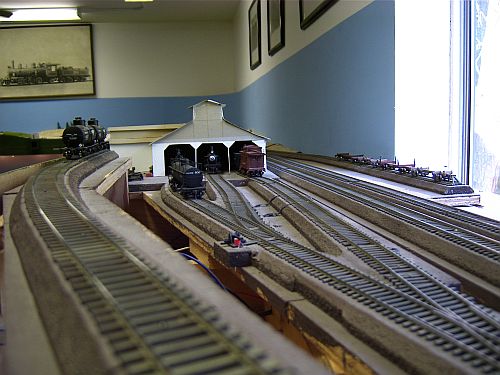
Looking at the Pickering engine house at Fassler. The cars on the left are TWOX tank cars that were brought to Fassler by the Sierra. They were originally spotted on the siding next to the mill pond and then during the next session the local Pickering switcher moved them to the spur at Fassler Oil. The correct reporting remarks for these cars should be AOX . The tank car in front of the engine house is a Pickering tank car that will be loaded with oil from the TWOX cars and then delivered out to Soap Creek by the logging trains. The loco on the middle track in the house is the Pickering #4 , a two truck Heisler that is used as the Yard Switcher. The caboose is coupled to Heisler #1, a three truck Heisler that makes two trips to Schoettgen Pass with empty log cars and brings back loaded cars. The empty log cars are on the log dump spur .
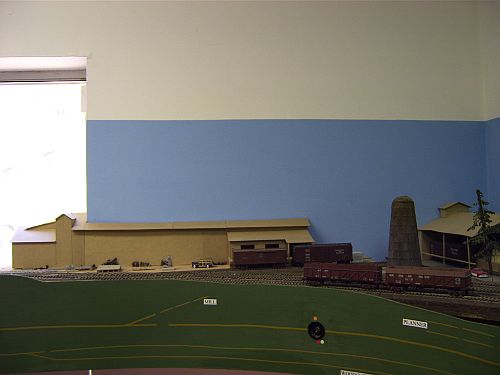
Looking at the mill at Fassler. The Pickering engine house is to the left. The Planner is on the right side of the photo. The two empties Woodchip cars are waiting to be loaded, the loader is just out of the picture on the right.
January 2011 – the Sierra mainline as it approaches Standard. That’s Cooperstown below Standard.
January 2011 – a close up of Standard. The buildings are just temporary. The station mock up on the left will be eventually finished as a wood structure. The two stall engine house, a FSM kit, represents the Speeder shed.
The east end of the Standard trackage. From here the mainline heads up to Black Oak.
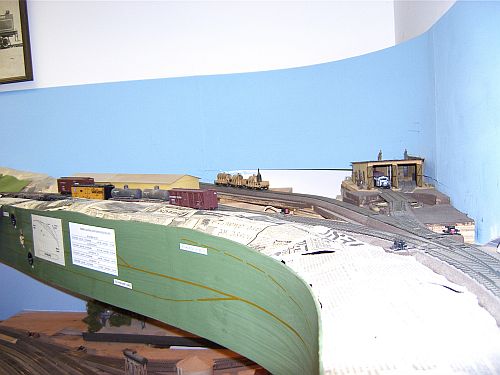
The Company Town of Standard. The speeder shop and small turntable is on the right. Currently we are using a Con-Cor Goose as our speeder. It runs out to Beardsley Flat and back to Standard each session. The Standard freight house is behind the string cars on the Standard yard track. Cars on this track are waiting to be taken out to the woods by the Pickering mill train.
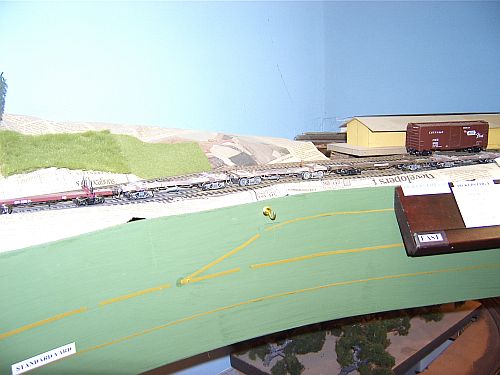
The east end of Standard. The string of empty log cars are waiting to be taken up to Schoettgen Pass by Pickering #1 where they will be picked up by the woods train, Shay #11 and #12 and taken to Soap Creek.
January 2011 – the upper deck is the Sierra mainline after leaving Standard. The shelfs on the upper right and lower right are removable to gain access to the back door that leads out of the crew lounge.
January 2011 – the Sierra mainline continues on its towards Draper Trestle and Black Oak. ‘Hanging Rock’ will be located on the left side of the track as the mainline curves through the wall. See the photo below for a photo of the prototype location.
This picture of the ‘Hanging Rock’ was taken the spring of 2000 looking west towards Standard, Draper Trestle would be behind you. It should be fun trying to duplicate the outcropping on the layout.
January 2011 – the Sierra mainline as it continues through the wall in the previous layout photo. The area at the bottom will be Draper Trestle. The siding at Black Oak begins as the track curves around the scenery.
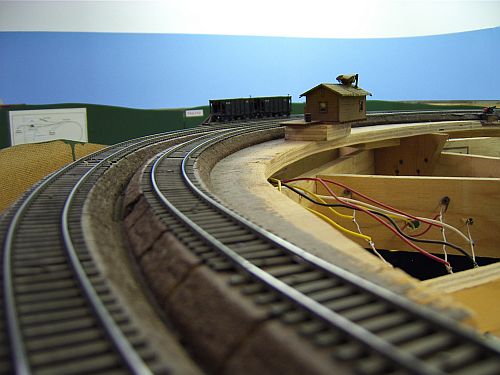
The siding at Black Oak. A frequent meeting place between Pickering log trains and Sierra passenger and freight trains between Standard and Ralph. The two Blackjack Hoppers are at a gravel unloading spur . The county used the gravel for road maintenance in the area.
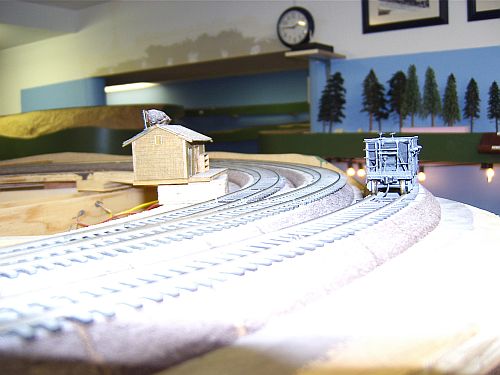
Another shot of Black Oak siding this time looking west. The creature on top of the building is why there are no trees in the area. In the background you can see one of four ‘fast’ clocks which are set to a 4 to 1 ratio, every 15 minutes of real time is equal to an hour on the layout. Also to the left the clock is the ‘Peeled Onion’ of the Pickering as it descends into the Stanislaus River canyon.
January 2011 – The east end of Black Oak siding. The track on the left is the spur leading to the gravel spur. The trees on the extreme left is the future location of the Black Oak Trestle. With the addition of all the base scenery there are fewer and fewer places to store trees until they are ready to be “planted”.
January 2011- The Sierra mainline running through Ralph. The two tracks closest to you are Pickering mainline and siding. The two tracks heading towards the wall are the Sierra mainline and its siding at Ralph.
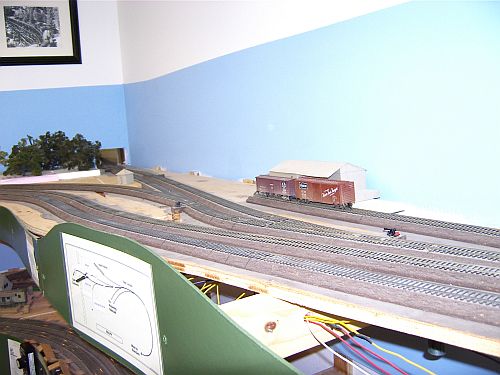
This is Ralph where the Pickering left the Sierra main and went out into the woods on its own trackage. The two box cars are spotted at the Apple Packing house off of the Sierra main. The Sierra main to Tuolumne runs through the hole in the wall. The two tracks closest to the fascia are the Pickering main and siding as they head towards Schoettgen Pass.
January 2011 – a close up the telephone booth at Ralph and the Pickering spur. The brown “road” between the Pickering tracks and the phone booth is Tuolumne Road as it heads down to Tuolumne.
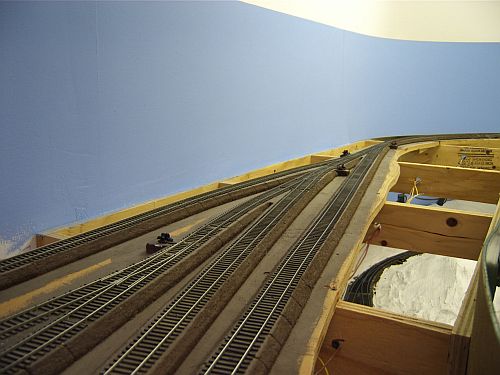
At Ralph looking west, the Black Oak trestle will be just out of the picture on the right. The track closest to the wall is the Apple Packing spur, next comes the Sierra main and finally the Pickering main and siding heading towards Schoettgen Pass.
January 2011 – A close up view of Tuolumne Rd and the Pickering track heading out to the woods and Schoettgen Pass.
January 2011- The Pickering mainline looking west back towards Ralph.
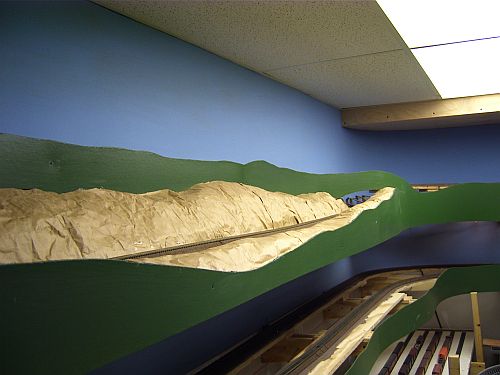
The Sierra mainline heading down to Tuolumne from Ralph. In the background the Pickering is crossing over the Sierra main to start its own deck on its way to Schoettgen Pass. The track on the next deck down is in the Keystone area. The track against the wall is the Groveland staging track which will have a scenery block in front of it at some point in time. The lowest level is the temporary SP Stockton staging yard.
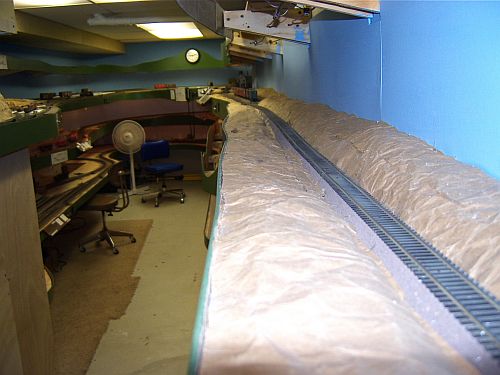
The Sierra main running east towards Tuolumne. The Tuolumne Depot and the Sierra Wye are in the back right hand corner. Across the aisle is the WSLCo mill and yard area.
Turnback Creek Trestle as you approach Tuolumne. (12-09)
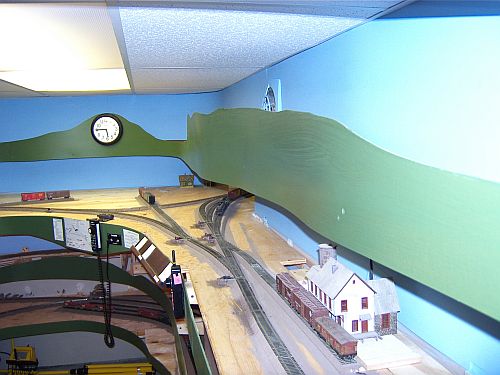
This an overview of the Sierra trackage in Tuolumne. The building in front is on the old Box Factory spur and will be Sassen Vinegar. In the middle of the picture is the Sierra wye with the depot just out of the picture on the right. Behind the fascia with one of the four ‘fast’ clocks is the Pickering mainline between Schoettgen Pass and the Peeled Onion. The trestle crossing Turnback Creek is just out of the picture at the bottom of the photo.
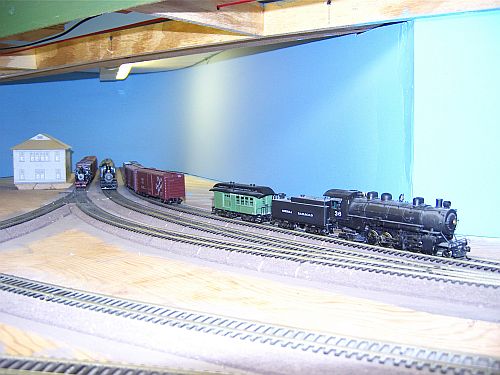
The Tuolumne Wye and yard tracks. The Sierra #36 with its Combine caboose is ready for the next westbound freight, Hill Job #9, to depart Tuolumne. On the middle track is the Sierra #3, a Bachmann 4-6-0 stand in, with Sierra Passenger #1 that will run all the way to Oakdale. And on the track closest to the depot (which is actually a mock up of the Jamestown depot) is the WSLCo #3 but in this case it’s numbered as #2. The WSLCo #2 a two truck Heisler does all the local switching in the Tuolumne area.
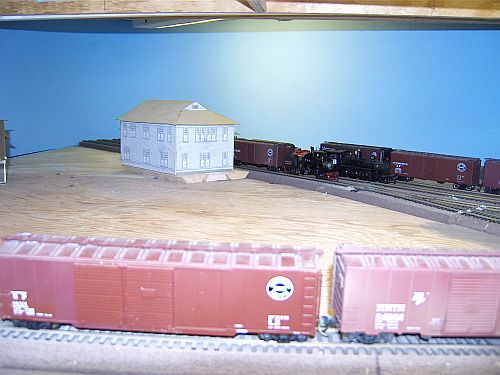
Another view of the Tuolumne Depot area. The two cars in the front of the photo have been set out on one the mill loading tracks. The WSLCo standard gauged switcher has spotted these cars and will pick them up when they are loaded. Once loaded they will be added to the westbound Hill Job #9 which is pulled by locomotive #36.
Railroad Pages
- Welcome
- About the Layout
- What's New
- Operations Overview
- Photos
- Prototype Track Drawings
- Contact/Location
- Research Sources
- Sierra Railroad Op Session Calendar
Sierra Historical & Modeling Seminar
Recent Posts
Post Archives
- August 2007 (1)
- May 2007 (1)
Post Categories
- Announcements (2)
Historical Groups
Model Mfgs
Operations
Other Layout Links
Other Sites
Meta
copyright © 2007-2024 John Zach -- WP-Design: Vlad -- Powered by WordPress -- site by webdancers



